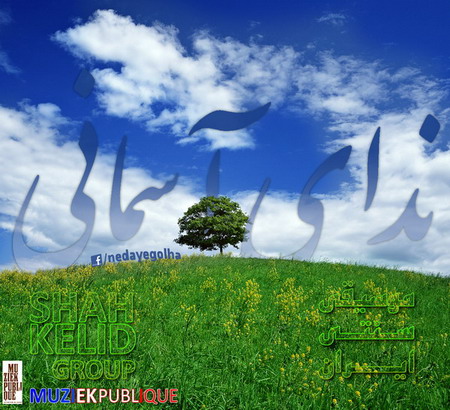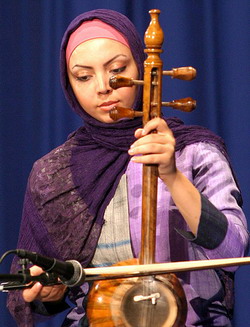با درود
اینجانب از نویسندگان وبلاگ ندای گلها هستم
از طرف گروه نویسندگان و مالک گروه ندای گلها به اطلاع شما عزیزان میرساند که ما
آقای (ابراهیمی) رو اصلاً نمیشناسیم و تاکید داریم که ایشان هیچ نقشی در تهیه و تدوین این مطالب ندارند
با تشکر - گروه نویسندگان ندای گلها
nedayegolha@yahoo.com
From: ali ebrahimi <lebrahimi106@gmail.com>
To: friends-of-radio-golha <Friends-of-Radio-Golha@googlegroups.com>
Sent: Monday, 21 November 2011, 11:46
Subject: دانلود آلبوم ندای آسمانی - موسیقی سنتی ایران
بادرودبه دوستان گراميم
تقديم به كليه دوستان اميدوارم لذت ببريد
باسپاس/ابراهيمي ازشيراز
NedayeGolha Group
Beautiful Iranian Traditional Music Album, "Nedaye Asemaani"
Arrangement by "Shah-Kelid" musicians group, and
published by "Muziekpublique™" company, France

Quality: Excellent
ZIP Downloading whole of album in a compressed file ...
Size: 44.7 Mb Server: MediaFire .......... Download
----------------------------
4 Goftegooye Setareha ...
Size: 15.0 Mb Server: PicoFile .......... Download
***

Iranian traditional music relies on both improvisation and composition, and is based on a series of modal scales and tunes which must be memorized. Apprentices and masters, ostad, have a traditional relationship which has declined during the 20th century as music education moved to universities and conservatories. The common repertoire consists of more than two hundred short melodic movements called gusheh, which are classified into seven dastgāh or "modes." Two of these modes have secondary modes branching from them called āvāz. Each gusheh and dastgah has an individual name.
This whole body is called the Radif of which there are several versions, each in accordance to the teachings of a particular master or ostad. A typical performance consists of the following elements pīshdarāmad(a rhythmic prelude which sets the mood), darāmad (rhythmic free motif), āvāz (improvised rhythmic-free singing), taṣnīf (rhythmic accompanied by singing, an ode), Chahārmeżrāb (rhythmic music but rhythmic-free or no singing), reng (closing rhythmic composition, a dance tune). A performance forms a sort of suite. Unconventionally, these parts may be varied or omitted. Towards the end of the Safavid Empire (1502-1736), more complex movements in 10, 14, and 16 beats stopped being performed. In fact, in the early stages of the Qajar Dynasty, the uṣūl(rhythmic cycles) were replaced by a meter based on the ghazal and the maqām system of classification was reconstructed into the Radif system which is used to this day (see Dast'gāh).
Today, rhythmic pieces are performed in beats of 2 to 7 with some exceptions. Rengs are always in a 6/8 time frame. Many melodies and modes are related to the maqāmāt of the Turkish classical repertoire and Arabic music belonging to various Arab countries, for example Iraq. This similarity is because of the exchange of musical science that took place in the early Islamic world between Persia and her neighboring countries. During the meeting of The Inter-governmental Committee for the Safeguarding of the Intangible Heritage of the United Nations, held between 28 September – 2 October 2009 in Abu Dhabi, radifs were officially registered on the UNESCO List of the Intangible Cultural Heritage of Humanity.
The classical music is vocal based. The vocalist plays a crucial role: she or he decides what mood to express and which dastgah relates to that mood. In many cases, the vocalist is also responsible for choosing the poems to be sung. If the performance requires a singer, the singer is accompanied by at least one wind or string instrument, and at least one type of percussion. There could be an ensemble of instruments, though the primary vocalist must maintain hers or his role. In some taṣnīf songs, the musicians may accompany the singer by singing along several verses. Traditionally, music is performed while seated on finely decorated cushions and rugs. Candles are sometimes lit. The group of musicians and the vocalist decide on which dastgahs and which of their gushehs to perform, depending on the mood of a certain time or situation.
A Sassanid era mosaic excavated at Bishapur
Iranian classical music continues to function as a spiritual tool as it has throughout its history, and much less of a recreational activity. Compositions can vary immensely from start to finish, usually alternating between low, contemplative pieces and athletic displays of musicianship called tahrir. The incorporation of religious texts as lyrics were replaced by lyrics largely written by medieval Sufi poets, especially Hafez and Jalal-e Din Rumi.
Authors Group of NedayeGolha (Cultural blog)
MooseMoosighi.MihanBlog.com
Beautiful Iranian Traditional Music Album, "Nedaye Asemaani"
Arrangement by "Shah-Kelid" musicians group, and
published by "Muziekpublique™" company, France

Quality: Excellent
ZIP Downloading whole of album in a compressed file ...
Size: 44.7 Mb Server: MediaFire .......... Download
----------------------------
-----------------------------
----------------------------
4 Goftegooye Setareha ...
Size: 15.0 Mb Server: PicoFile .......... Download
----------------------------
----------------------------
----------------------------
----------------------------
***

Iranian Traditional Music
Iranian traditional music relies on both improvisation and composition, and is based on a series of modal scales and tunes which must be memorized. Apprentices and masters, ostad, have a traditional relationship which has declined during the 20th century as music education moved to universities and conservatories. The common repertoire consists of more than two hundred short melodic movements called gusheh, which are classified into seven dastgāh or "modes." Two of these modes have secondary modes branching from them called āvāz. Each gusheh and dastgah has an individual name.
This whole body is called the Radif of which there are several versions, each in accordance to the teachings of a particular master or ostad. A typical performance consists of the following elements pīshdarāmad(a rhythmic prelude which sets the mood), darāmad (rhythmic free motif), āvāz (improvised rhythmic-free singing), taṣnīf (rhythmic accompanied by singing, an ode), Chahārmeżrāb (rhythmic music but rhythmic-free or no singing), reng (closing rhythmic composition, a dance tune). A performance forms a sort of suite. Unconventionally, these parts may be varied or omitted. Towards the end of the Safavid Empire (1502-1736), more complex movements in 10, 14, and 16 beats stopped being performed. In fact, in the early stages of the Qajar Dynasty, the uṣūl(rhythmic cycles) were replaced by a meter based on the ghazal and the maqām system of classification was reconstructed into the Radif system which is used to this day (see Dast'gāh).
Today, rhythmic pieces are performed in beats of 2 to 7 with some exceptions. Rengs are always in a 6/8 time frame. Many melodies and modes are related to the maqāmāt of the Turkish classical repertoire and Arabic music belonging to various Arab countries, for example Iraq. This similarity is because of the exchange of musical science that took place in the early Islamic world between Persia and her neighboring countries. During the meeting of The Inter-governmental Committee for the Safeguarding of the Intangible Heritage of the United Nations, held between 28 September – 2 October 2009 in Abu Dhabi, radifs were officially registered on the UNESCO List of the Intangible Cultural Heritage of Humanity.
The classical music is vocal based. The vocalist plays a crucial role: she or he decides what mood to express and which dastgah relates to that mood. In many cases, the vocalist is also responsible for choosing the poems to be sung. If the performance requires a singer, the singer is accompanied by at least one wind or string instrument, and at least one type of percussion. There could be an ensemble of instruments, though the primary vocalist must maintain hers or his role. In some taṣnīf songs, the musicians may accompany the singer by singing along several verses. Traditionally, music is performed while seated on finely decorated cushions and rugs. Candles are sometimes lit. The group of musicians and the vocalist decide on which dastgahs and which of their gushehs to perform, depending on the mood of a certain time or situation.
A Sassanid era mosaic excavated at Bishapur
Iranian classical music continues to function as a spiritual tool as it has throughout its history, and much less of a recreational activity. Compositions can vary immensely from start to finish, usually alternating between low, contemplative pieces and athletic displays of musicianship called tahrir. The incorporation of religious texts as lyrics were replaced by lyrics largely written by medieval Sufi poets, especially Hafez and Jalal-e Din Rumi.
Authors Group of NedayeGolha (Cultural blog)
MooseMoosighi.MihanBlog.com
از طرف گروه ندای گلها
nedaye-golha@googlegroups.com




No comments:
Post a Comment